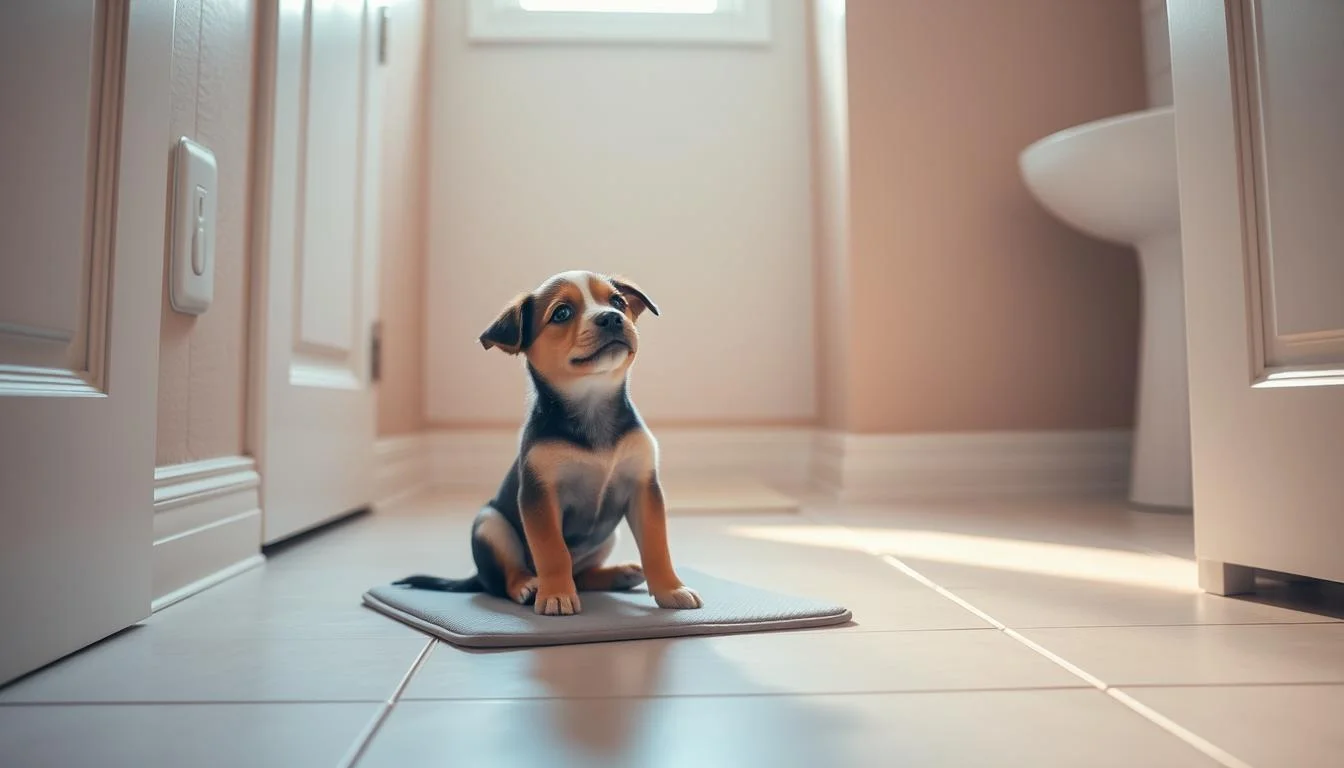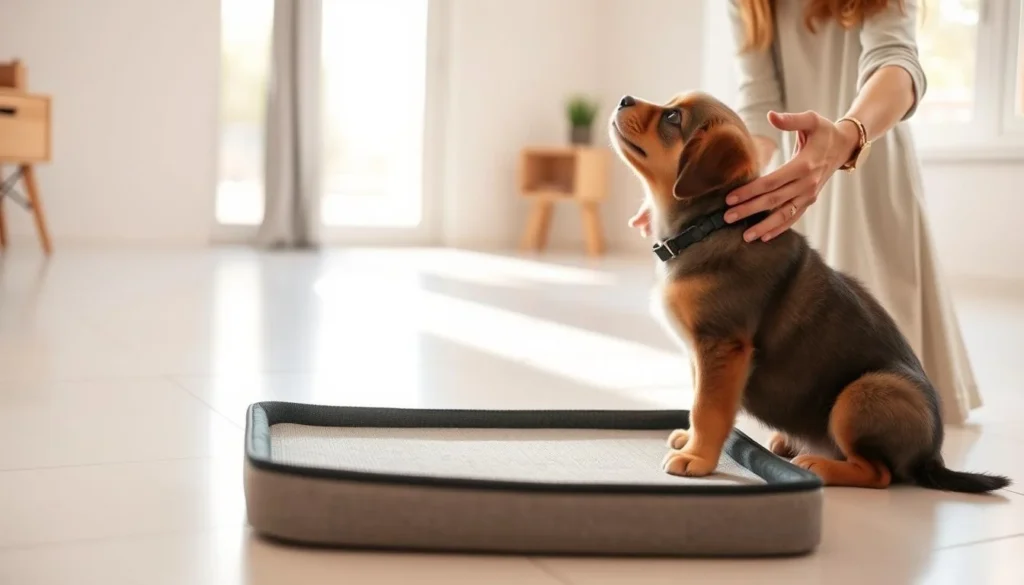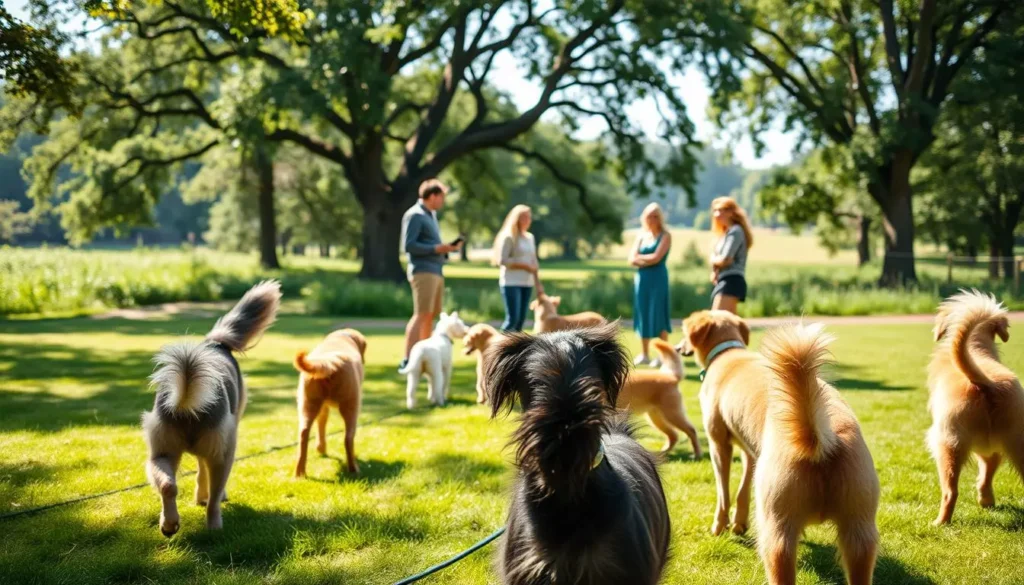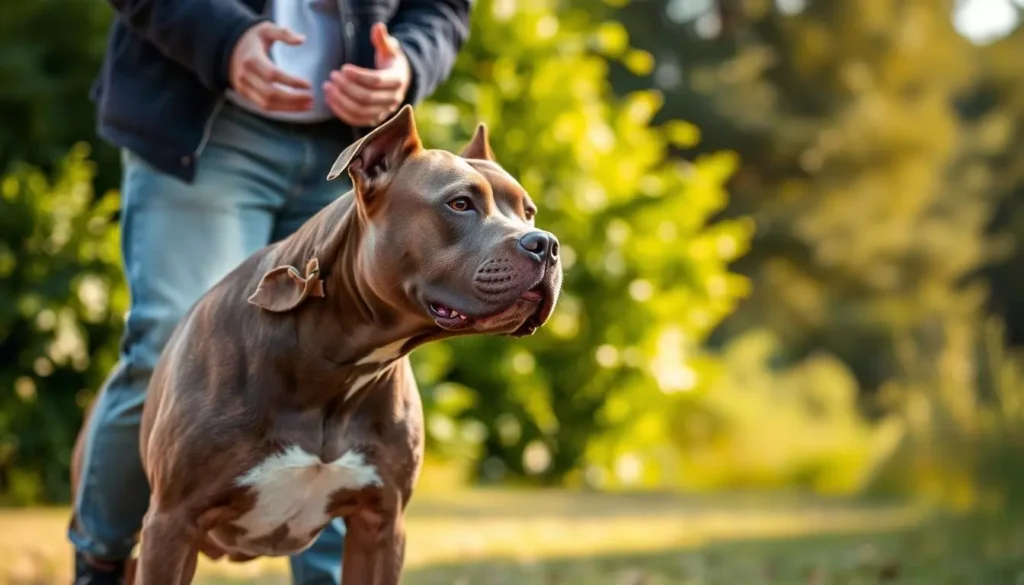I remember the first week with my puppy. It was full of excitement and tiny accidents. I wanted to potty train him easily for calm mornings and fewer messes.
I wanted our bond to grow strong, not weak from frustration. So, I planned carefully and chose the right methods for my life.
Potty training is key for a happy life together. Before bringing my puppy home, I researched and planned. I set realistic goals and picked tools that fit my schedule.
I learned that repetition, clear cues, and positive rewards work best. Punishment doesn't help.
I aim to share practical tips for potty training. These tips are realistic and gentle. We'll cover schedules, crate use, supervision, rewards, and how to fix problems.
Key Takeaways
- Potty training sets the foundation for a calm, clean home and a well-behaved dog.
- Planning before bringing a puppy home makes training easier and less stressful.
- Consistent cues, repetition, and positive reinforcement are central to success.
- Using schedules, supervision, and confinement tools speeds learning and prevents accidents.
- The approach should match your routine and the puppy’s age for best results.
Why potty training matters for a happy home
I knew housetraining was key when my puppy came home. Good routines help with other lessons and reduce confusion. Early on, I focused on puppy housebreaking strategies, creating a calm and predictable home.
How housebreaking sets the foundation for good behavior
Housebreaking teaches a puppy when and where to go. By repeating simple steps and rewarding them, they learn clear rules. This practice helps with obedience, leash training, and social skills.
Health, hygiene, and reducing stress for me and my puppy
Clean floors and fewer accidents keep our home healthy and fresh. Using effective puppy potty training methods saves me from constant cleaning. My puppy feels secure with a routine, and I enjoy a peaceful home.
When to start training and planning before bringing a puppy home
I started planning before picking up my puppy. I mixed crate training with outdoor trips. Starting right away helps set a verbal cue and consistent bathroom times. Successful puppy potty training requires patience, a plan, and regular outings in the first weeks.
Creating a consistent potty training schedule
I plan potty time so my puppy learns predictability. A steady routine supports efficient puppy toilet training and helps me spot patterns. I use the same short command every trip so my pup links the place with the action.
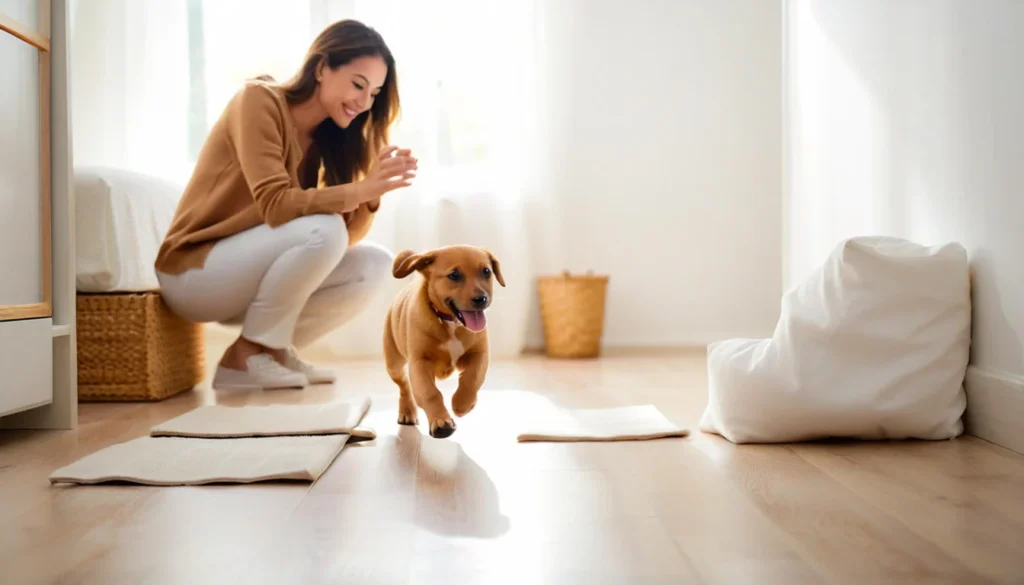
I stick to fixed feeding times and small, even meals. This makes elimination windows easier to predict and speeds learning with quick puppy potty training methods.
Feeding times and predictable elimination windows
I feed three small meals at consistent times each day. Puppies often need to go shortly after eating. When meals are regular, I can plan breaks right after breakfast, lunch, and dinner.
Frequency guide by age and bladder control milestones
A simple rule I follow: a puppy can usually hold urine for hours roughly equal to their age in months up to about nine months. For very young pups I take them out at least every two hours and after naps, play, or meals.
How I structure morning, daytime, and nighttime routines
My morning starts with an immediate outdoor trip. I follow with a short walk after breakfast and play. Midday includes two planned breaks, one after a nap and one after lunch. Late afternoon gets another outing before a final calm session in the evening.
At night I remove water about 2.5 hours before bedtime to lower the chance of accidents. Most puppies can sleep around seven hours, though I adjust for my dog's needs. If I'm away, I schedule a dog-walker or neighbor break to keep the pattern steady.
| Time | Action | Why it helps |
|---|---|---|
| First thing | Immediate outside trip | Reinforces the habit and reduces morning accidents |
| After meals | Bathroom break within 10–15 minutes | Matches natural elimination after eating and supports quick puppy potty training methods |
| After play or naps | Short outdoor visit | Prevents accidents from excitement or waking |
| Midday | One to two scheduled breaks | Maintains routine when I am working or out |
| Evening | Late afternoon and pre-bed trip | Reduces late-night accidents and sets calm bedtime habits |
These puppy potty training tips help me stay consistent. Small steps, steady timing, and clear cues make house training smoother and faster.
Crate training as the easiest and fastest way to potty train a puppy
I use crates because they help dogs feel safe and make it easy to watch them. A crate can reduce accidents, make travel easier, and speed up learning with a good schedule.
For quick and positive crate training, I follow a few key tips. Begin with short times, feed in the crate, and add a favorite toy. Praise your puppy for calm behavior. This builds trust and makes the crate a cozy spot.
I pick a crate that allows my puppy to move freely but not roam. Too much room can lead to accidents and uneven sleep. I adjust the crate size with partitions as my puppy grows, keeping them comfortable and learning on track.
I watch for signs like whining or scratching. If I see these, I take my puppy out right away. Letting them soil the crate is a bad habit and slows training. For a rescue pup, I tighten their diet, increase outdoor time, and watch closely until they learn.
I only use the crate for naps, bedtime, and when I'm not around. It's never a punishment. I keep sessions short to avoid stressing my puppy. This follows the best methods for potty training and keeps things calm.
If mistakes happen, I stay calm and start again. Regular breaks, consistent feeding, and rewards help train my puppy fast. If problems continue, I talk to a vet or trainer to check for health or behavior issues.
Using puppy pads and indoor solutions when needed
I use puppy pads when it's hard to go outside. They give a clear spot for young dogs to go inside. This helps me keep up with housebreaking plans.
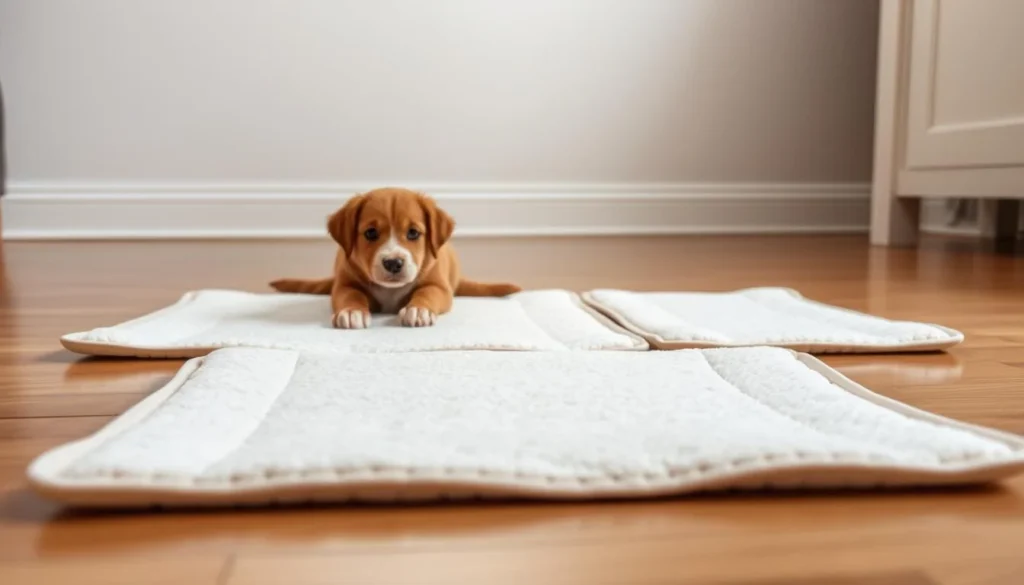
Before using pads, I think about the long-term effects. Pads can make it harder for puppies to learn to go outside. I keep the pads in the same place and take my puppy outside often.
I have a simple plan to use pads wisely. I start by placing pads near the back door. Then, I move them a little bit each day towards the door. When the pad is right outside, I praise and treat my puppy for going outside.
Some pads are very good at soaking up and controlling smells. This is great for small places and at night. For tiny breeds, very cold weather, or when schedules are unpredictable, pads are very helpful.
Below, I compare different pads and their uses. This helps you find the right pad for your needs and training goals.
| Use Case | Pad Feature | Benefit | Training Tip |
|---|---|---|---|
| Apartment living | Extra absorbent, odor-lock | Reduces odor, protects floors | Place near door; pair each pad visit with outdoor reward |
| Nighttime coverage | Overnight pads or thicker layers | Prevents leaks while puppy learns bladder control | Limit water before bed and take out first thing in morning |
| Tiny breeds (example: yorkie) | Small, highly absorbent pads | Mimics small target area; useful for the easiest way to potty train a yorkie puppy | Combine pad use with frequent outdoor trips to avoid permanent indoor habit |
| Severe weather or long workdays | Durable pads with adhesive backing | Stays in place, handles multiple uses | Rotate pads and clean area; schedule outdoor sessions when possible |
| Health tracking | Health-tracker style pads | Helps monitor urine changes and frequency | Note changes and consult vet if needed |
When I use pads in playpens or crates, I watch for repeated indoor use. If my puppy uses the pad too much, I cut back on pads and focus on outdoor training. Being consistent is key in housebreaking.
In short, pads are helpful when used correctly. I choose good pads, keep them in the same place, and plan for outdoor training. This way, pads are a temporary help, not a permanent solution.
Recognizing signals and supervising for quick puppy potty training
I keep a close eye on my puppy to catch early signs they need to go out. I look for sniffing the floor, circling, squatting, whining, and scratching at the door. Acting fast helps prevent accidents and strengthens the connection between signaling and going outside.
Supervising closely is key to effective puppy potty training. I watch my puppy during waking hours to quickly move them to the potty spot. This quick action speeds up learning and reduces frustration for both of us.
I use a 6-foot leash indoors or tether my puppy to me to keep them close. The leash stops them from sneaking off and missing chances to go outside. I treat the yard like any other room and keep the puppy leashed there during training to reward correct behavior right away.
When I'm not around, I use a crate or a small gated area to keep them safe. If my schedule is tight, I arrange for a trusted neighbor or dog walker to take the puppy out on a consistent schedule. These steps help keep training on track and support quick puppy potty training methods.
Here are some practical puppy potty training tips I follow:
- Respond immediately to whining or door-scratching to reinforce signals.
- Keep short, frequent outdoor trips after eating, sleeping, or play sessions.
- Use a leash indoors for close supervision and prompt action.
- Confine safely when I can’t watch my puppy to avoid long unsupervised stretches.
- Reward outside success quickly so my puppy links the action to praise or treats.
| Situation | Supervision Strategy | Expected Result |
|---|---|---|
| First wake-up of the day | Immediate leash walk to potty spot | Fast success and strong morning routine |
| After meals or play | Watch for sniffing and circling; take out within minutes | Fewer indoor accidents and clearer bladder patterns |
| Short periods when I’m busy | Use a crate or gated area with a scheduled break | Maintained training gains without unsupervised mistakes |
| Outdoor training sessions | Keep puppy leashed and reward immediately for correct spots | Faster reinforcement and reliable outdoor habits |
Positive reinforcement and reward-based training techniques
I use calm, consistent rewards to teach my puppy where to go. Positive reinforcement makes lessons clear. I pick a single cue like "potty" or "go potty" and repeat it each time at the elimination spot.
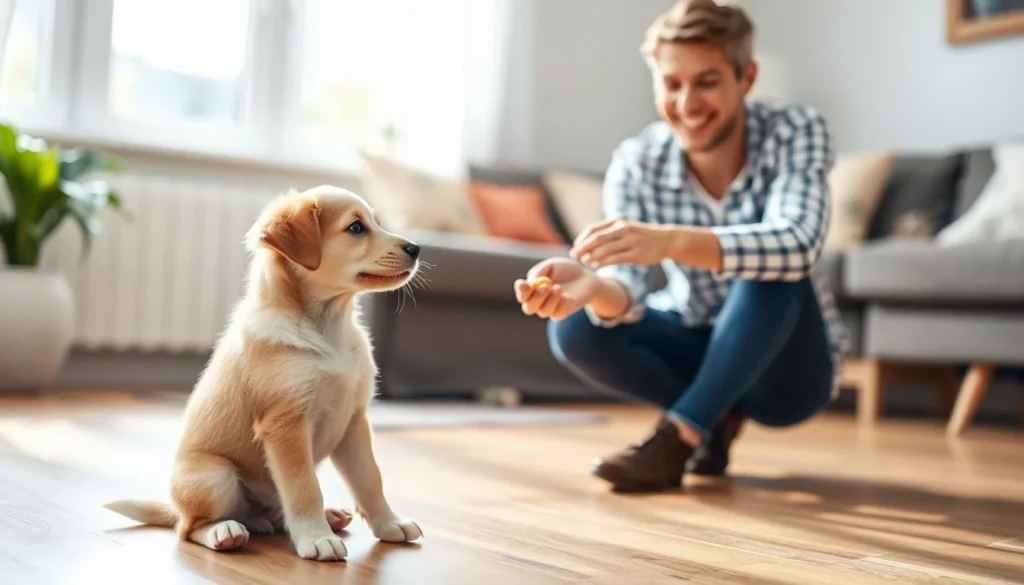
Timing is key. I wait until my puppy is fully finished before rewarding. Giving treats too early can make my dog stop midstream.
Right after my pup finishes, I offer praise and a tiny treat. This makes the connection immediate.
My go-to rewards are small, soft treats, a quick play burst with a Kong or ball, or upbeat verbal praise. I avoid large snacks that upset digestion. These choices support the best puppy potty training techniques by keeping rewards consistent and easy to deliver.
I keep training sessions short and positive. If an accident happens, I clean the area with an enzymatic cleaner and skip scolding. Punishment can harm trust and slow progress. Cleaning removes odor so my puppy is less likely to repeat the spot.
Below is a simple guide I follow to link good behavior with rewards and reach successful puppy potty training more quickly.
| Step | Action | Why it works |
|---|---|---|
| 1. Choose a cue | Say "potty" each time at the spot | Builds an audio link between cue and behavior |
| 2. Watch for signals | Take pup out when sniffing or circling | Prevents accidents and reinforces timing |
| 3. Wait until finished | Hold off on praise until elimination ends | Prevents premature stops and strengthens learning |
| 4. Reward immediately | Give a small treat, brief play, and praise | Creates a strong, positive association |
| 5. Clean calmly | Use enzymatic cleaner after accidents | Removes scent cues and avoids fear from scolding |
| 6. Stay consistent | Use same cues, rewards, and schedule | Consistency drives the best puppy potty training techniques |
Managing diet and its role in successful puppy potty training
I focus on diet because feeding times shape when my puppy needs to go. A steady routine makes trips outside predictable and reduces accidents. By managing puppy diet for potty training, I create clear windows for bathroom breaks that match feeding and play schedules.
I feed three small meals a day to match a young pup's immature digestive system. This helps with efficient puppy toilet training since puppies often eliminate soon after eating. I check stools each day; bulky, loose, or stinky stools tell me the food may not agree and I should consider a change or vet advice.
I control portions to avoid overfeeding, which can cause diarrhea and stall progress. I pick a high-quality puppy formula from brands like Royal Canin or Purina Pro Plan that suits my puppy's breed and size. Proper portion control and a stable kibble help keep potty windows regular and support puppy potty training tips I trust.
I limit water at night to lower the chance of overnight accidents. I remove the bowl about 2.5 hours before bedtime, adjusting for my pup's age and any vet recommendations. During the day, I keep fresh water available so hydration stays healthy without ruining my bedtime routine.
Below is a simple feeding and potty schedule I use. It aligns meals, short walks, and play so elimination becomes predictable and training stays efficient.
| Age | Meals per day | Typical potty timing | Water rule before bed |
|---|---|---|---|
| 8–12 weeks | 3–4 small meals | 15–30 min after each meal; every 1–2 hours otherwise | Remove 2–2.5 hours before sleep, monitor naps |
| 3–6 months | 3 meals | 15–30 min after meals; every 2–3 hours between | Remove 2.5 hours before bedtime, adjust as needed |
| 6–12 months | 2–3 meals | 15–30 min after meals; longer bladder control possible | Remove ~2.5 hours before bed; extend overnight gradually |
Quick tips I follow: keep feeding times consistent, watch stool quality, and avoid free-feeding. These small steps make efficient puppy toilet training smoother and align with practical puppy potty training tips that work in real homes.
Troubleshooting common potty training challenges
I stay calm when accidents happen because yelling confuses a puppy. It slows their learning. I take my pup to the chosen potty spot calmly. If they finish there, I reward them right away. This helps solve potty training problems without scaring them.
Cleaning is key. I blot liquids from carpets before using an enzymatic cleaner. This removes odors that might attract a puppy back. A deep clean often solves problems faster than scolding.
If a puppy soils the crate, I check their schedule and bladder control. I make crate time tighter and return to short, consistent outings. Rescue dogs might need full re-training if they were forced to eliminate in kennels before.
If a pup keeps choosing one corner, I treat it as an odor problem. I clean thoroughly and then change the training area or add a barrier. Small changes can break the habit.
I use crate training tips like gradual increases in crate duration and frequent breaks. Keeping the crate positive and the right size reduces accidents. This improves bladder control over weeks.
Persistent or sudden issues make me think about health. I schedule a vet exam to check for infections, parasites, or urinary problems. If the vet clears medical causes, I get help from a certified trainer or animal behaviorist.
Signs to act include blood in urine, straining, sudden loss of housetraining, or pain when eliminating. Knowing when to contact a vet for potty issues helps the pup get back on track quickly.
Breed-specific tips: easiest way to potty train a lab, pitbull, and yorkie puppy
I adjust my training method based on the puppy's energy, bladder size, and personality. Here are some tips for Labradors, pitbulls, and Yorkies that have proven effective.
For any breed, I start with short, regular sessions. I praise them immediately after they go outside. Crate training helps prevent accidents and teaches bladder control.
Approaches for energetic breeds like Labrador retrievers
Labradors need to run before they go potty. I take them out after play or a run. This way, they go when they're calm. Using treats and a consistent routine helps a lot.
I match their meals with exercise times. This way, they learn to go outside after play and get a reward. Young Labs don't wait long to go out.
What works well for strong-willed breeds such as pitbull puppies
Pitbulls need clear rules and quick rewards. I'm firm but friendly, and use a strict schedule. Crate training and positive reinforcement work well for them.
Training should be calm and consistent. Short walks, praise, and treats right after help them accept rules without force.
Special considerations for small breeds like yorkies and toy dogs
Small breeds need to go out more often and eat smaller meals. If it's bad weather, I start with indoor potty spots. Then, I move them outside as they get better.
I watch their urine patterns and adjust their schedule. For young Yorkies, I take them out every one to two hours. Rewarding them right away helps a lot.
Conclusion
I started by planning before bringing my puppy home, and that preparation made a big difference. I used patience and persistence to create a steady schedule and crate training. I also made sure to supervise closely and reward them immediately.
This mix is the easiest way to potty train my puppy. It helps them learn quickly and understand what's expected.
Being consistent with cues, feeding times, and praise helped me a lot. Using the best puppy potty training techniques, like crate training and enzymatic cleaners, keeps things clean. Most puppies learn to go potty outside in a few months with a consistent routine.
Successful puppy potty training also means asking for help when I'm away. A dog walker or neighbor visit helps prevent long gaps. If problems keep happening, I talk to my vet or a certified trainer.
In short, plan ahead, be consistent, reward promptly, and stay calm. This combination has been my practical takeaway for lasting success.

